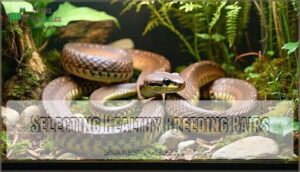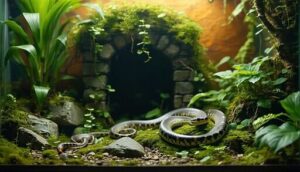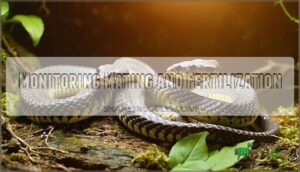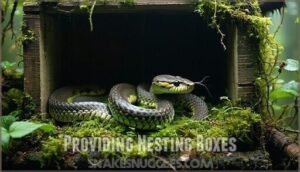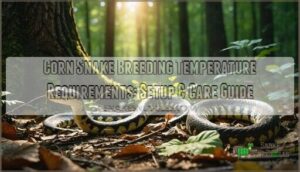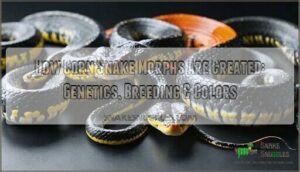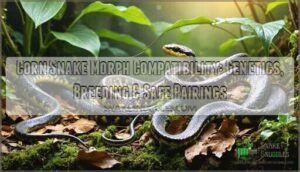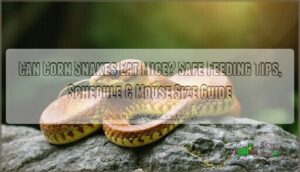This site is supported by our readers. We may earn a commission, at no cost to you, if you purchase through links.
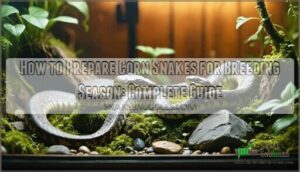 Successful corn snake breeding doesn’t start when you pair your snakes—it starts months earlier, during a calculated period of environmental manipulation that separates experienced breeders from those who wonder why their snakes won’t mate.
Successful corn snake breeding doesn’t start when you pair your snakes—it starts months earlier, during a calculated period of environmental manipulation that separates experienced breeders from those who wonder why their snakes won’t mate.
Preparing corn snakes for breeding season demands precise temperature cycling, strategic nutrition adjustments, and careful genetic selection that directly determines clutch viability and hatchling survival rates. Skip the brumation phase or rush post-cooling recovery, and you’ll watch your breeding window close without a single fertile egg.
This guide walks you through each sequential step—from initiating brumation protocols through incubation management—so you control reproductive outcomes rather than leaving them to chance.
Table Of Contents
- Key Takeaways
- Planning for Corn Snake Breeding Season
- Preparing Corn Snakes for Brumation
- Selecting Healthy Breeding Pairs
- Ensuring Genetic Diversity and Ethics
- Optimizing Habitat Conditions for Breeding
- Nutrition and Conditioning Before Breeding
- Introducing Males and Females for Mating
- Monitoring Mating and Fertilization
- Egg Laying, Incubation, and Care
- Post-Breeding and Hatchling Care
- Frequently Asked Questions (FAQs)
- Conclusion
Key Takeaways
- Successful corn snake breeding requires a calculated 8-12 week brumation period at 50-60°F followed by gradual warming to trigger the hormonal changes necessary for reproduction—skipping or rushing this phase eliminates your breeding window entirely.
- Breeding pairs must meet the "333 rule" (3 years old, 300 grams, 3 feet long) and pass veterinary screening for parasites and diseases before pairing, as underweight females risk egg-binding and sick snakes transmit problems that collapse the entire breeding cycle.
- Precise incubation control at 78-82°F with 85-90% humidity over 60-70 days determines whether eggs develop into healthy hatchlings or fail, making temperature stability and daily monitoring non-negotiable for clutch success.
- Genetic diversity through documented lineage tracking and avoiding pairings that exceed 12.5% inbreeding coefficient prevents deformities, reduces hatch rates, and protects long-term population health across breeding seasons.
Planning for Corn Snake Breeding Season
Successful corn snake breeding starts with understanding when and why these snakes reproduce. The natural breeding cycle is driven by seasonal changes, but captive conditions give you more control over timing.
Here’s what you need to know about planning your breeding season.
Timing The Breeding Cycle
Getting the timing right means lining up your breeding schedule with your snakes’ natural reproductive rhythm—and that starts months before you ever introduce a pair.
Your breeding cycle unfolds in four critical phases:
- Brumation Period (8-12 weeks at 50-60°F)
- Post-brumation warm-up (gradual temperature control increase)
- Breeding windows (March-April peak mating cues)
- Incubation (60-70 days post-laying)
Each phase triggers hormonal shifts that prepare your corn snakes for successful reproduction.
Understanding Seasonal Triggers
Your snakes won’t breed reliably without the right environmental signals—temperature and light work together to flip their reproductive switch. Two seasonal triggers matter most: photoperiod (light duration) and temperature cues during brumation periods.
| Environmental Signal | Winter Phase | Spring Phase | Effect |
|---|---|---|---|
| Photoperiod | 9-10 hours light | Increase to 13 hours (gradual 15-30 min steps every 2 weeks) | Synchronizes hormonal changes for mating readiness |
| Temperature | 50-61°F for 60-90 days | Return to 75-81°F (basking to 90°F) over 1-2 weeks | Triggers sperm production and ovulation timing |
After brumation, females usually shed within 1-2 weeks—that’s your signal that ovulation and pheromone release are underway. Males respond with increased activity and food refusal once these seasonal cycles align. Understanding corn snake breeding is essential for successful reproduction.
Geographic and Captive Influences
Wild corn snakes in Florida might hit breeding readiness weeks before their Appalachian cousins do—and in captivity, you control those timing levers yourself. Regional variations in climate directly shape natural seasonal cycles, but captive environments let you manipulate temperature gradients and photoperiods to trigger brumation regardless of your location.
By adjusting habitat modifications—cooling protocols, lighting schedules—you’re fundamentally overriding geographic influences to synchronize your captive breeding timeline with ideal conditions.
Preparing Corn Snakes for Brumation
Brumation isn’t just a winter nap—it’s the biological reset that prepares your corn snakes for successful reproduction. Getting the temperatures, timing, and shift right makes all the difference between healthy breeding and wasted effort.
Brumation is the biological reset that separates successful corn snake breeding from wasted effort—nail the temperatures, timing, and transitions or risk failure
Here’s how to manage each critical phase of the brumation process.
Setting Brumation Temperatures
The key to triggering your corn snakes’ reproductive instincts lies in dropping their environment to a precise 50-60°F range—too warm and you’ll miss the hormonal reset, too cold and you risk metabolic shutdown.
Use a thermostat-controlled setup to maintain consistent temperature control throughout the brumation cycles, preventing cold stress while supporting proper thermoregulation.
This winter cooling period resets breeding season hormones without compromising your snakes’ health before incubation temperature planning begins.
Duration and Monitoring
Consistently maintaining brumation for 8-12 weeks gives your corn snakes’ reproductive systems enough time to reset hormones and prime breeding readiness—but weekly weight checks and behavioral observations prevent you from missing early signs of stress or dehydration.
Track temperature fluctuations daily and document your snakes’ activity levels throughout the brumation period, ensuring this controlled cooling phase properly synchronizes their breeding cycle before you shift into post-breeding care and incubation planning.
Safely Ending Brumation
Gradually warming your snakes back to their active temperature range over 5-7 days prevents shock and signals their bodies that breeding season has arrived. Restore thermal gradients incrementally—start at 65°F, then increase by 3-5°F daily until you reach 75-85°F—while monitoring behavior for lethargy or refusal to bask.
Resume feeding 48 hours after full temperature acclimation to support post-brumation care and breeding readiness.
Selecting Healthy Breeding Pairs
Choosing the right breeding pair isn’t just about bringing two snakes together—it’s about ensuring both animals are physically ready, disease-free, and temperamentally suited for reproduction. Your success hinges on careful evaluation before you ever introduce them.
Here’s what you need to assess in each potential breeding candidate.
Age and Weight Requirements
Before you commit to breeding season, verify your corn snakes meet the "333 rule": 3 years old, 300 grams, and 3 feet long. Females below these maturity signs risk egg-binding and poor clutch viability. Males can breed at 2 years, though 3 is safer.
Growth rates vary, but rushing size requirements through overfeeding compromises health and genetic diversity outcomes.
Screening for Diseases and Injuries
Breeding a corn snake with parasites, respiratory infection, or hidden injuries is like building a house on a cracked foundation—the entire process collapses under stress. Schedule veterinary exams to confirm your snakes are breeding-ready. Thorough health checks and parasite control protect genetic diversity and prevent disease transmission.
Pre-breeding veterinary care includes:
- Fecal tests for internal parasites and protozoa
- Respiratory assessments checking for wheezing or discharge
- Skin inspections revealing mites, scars, or scale rot
- Injury assessment examining spinal alignment and old wounds
- Weight verification confirming adequate conditioning without obesity
Assessing Temperament and Behavior
A calm, predictable snake transforms breeding from a wrestling match into a smooth collaboration—but an aggressive or stressed individual turns every pairing into a high-risk gamble. Conduct temperament tests through routine snake management sessions. Observe behavioral traits like defensive strikes, feeding aggression, and stress responses.
Socialization methods and stress reduction techniques improve snake temperament, while behavioral genetics influence mating behavior. Select snakes that tolerate management without prolonged defensive posturing—cooperative individuals simplify snake breeding and minimize injury risks during copulation.
Ensuring Genetic Diversity and Ethics
Breeding corn snakes responsibly means looking beyond just pairing healthy adults. You need to factor in genetic diversity, understand inbreeding risks, and follow ethical standards that protect both your snakes and the broader captive population.
Let’s break down what you need to know before planning your next pairing.
Importance of Genetic Variation
Genetic diversity is the cornerstone of healthy corn snake populations—think of it as insurance against future problems. Without it, you’re rolling the dice on weak offspring and preventable health issues. Strong genetic variation builds resilience into your breeding program from day one. Understanding the role of the CLCN2 gene function is vital for managing genetic diversity in corn snakes.
- Genetic diversity strengthens immune function and reduces susceptibility to diseases
- Hybrid vigor emerges when unrelated bloodlines combine, producing sturdy offspring
- Gene pool expansion preserves heritability traits like temperament and longevity
- Genetic screening identifies carriers of recessive disorders before pairing
- Genetic health improves when you document lineages and avoid repeat pairings
Avoiding Inbreeding Risks
Once you’ve prioritized genetic diversity, you’re ready to address inbreeding risks head-on. Pairing closely related snakes—parent-offspring or sibling-sibling—produces a 25% inbreeding coefficient, markedly increasing visible deformities like vertebral kinks and cranial malformations. Half-sibling pairings yield 12.5% COI, while first-cousin pairings generate 6.25%.
Responsible breeders maintain multi-generation pedigrees to calculate COI for every pairing and generally exclude pairs exceeding 12.5%. Without detailed lineage records, you risk reduced hatch rates, decreased fertility, and immunological deficits that compromise long-term health and reproductive potential.
Ethical Breeding Practices
Beyond tracking coefficients and lineage charts, you’ll need to commit to breeding practices that safeguard both animal welfare and the reputation of the hobby itself. Responsible breeding practices prioritize animal welfare and conservation by refusing to produce snakes you can’t properly house or place.
Ethical breeding considerations demand culling non-viable morphs humanely, maintaining transparent health records, and educating buyers on long-term care requirements—sustainable practices that strengthen genetic health and diversity priorities while protecting the broader conservation impact of captive breeding.
Optimizing Habitat Conditions for Breeding
Creating the right habitat conditions isn’t just about comfort—it’s about triggering biological responses that make breeding possible. Your enclosure setup directly influences reproductive hormones, courtship behavior, and egg viability.
Here’s what you need to dial in before introducing your breeding pairs.
Temperature and Heating Setup
Maintaining precise thermal gradients throughout your breeding enclosure forms the foundation of successful corn snake reproduction. You’ll need reliable heating elements like under-tank heat pads or ceramic emitters connected to a quality thermostat. Establish a warm side at 85°F and a cool side at 75°F, allowing your snakes to thermoregulate naturally.
This thermal gradient becomes especially critical during incubation, where steady temperature control between 80-84°F determines hatchling viability and development rates.
Humidity and Ventilation Control
While temperature controls growth, humidity levels between 50-60% during breeding season prevent respiratory issues and support proper shedding cycles that indicate reproductive readiness. Adequate ventilation systems preserve air quality without creating drafts that destabilize temperature gradients, particularly during the critical incubation phase when 75-80% humidity becomes essential.
- Monitor humidity twice daily using calibrated digital hygrometers
- Install screened vents on opposite enclosure sides for cross-ventilation
- Mist enclosures lightly if levels drop below 50%
- Increase air exchange during high-humidity incubation to prevent mold
Enclosure Design for Breeding
Your breeding enclosure functions as both nursery and sanctuary—designing a space that accommodates courtship rituals, gravid female security needs, and safe egg deposition requires forethought that extends beyond basic housing parameters.
Enclosure size starts at 40-gallon capacity for breeding pairs, enabling proper thermal gradient establishment from warm to cool zones while ventilation strategies prevent stagnant air that compromises humidity control.
| Design Element | Breeding Specification |
|---|---|
| Enclosure Size | 40+ gallons for pairs |
| Temperature Gradients | 75°F cool to 85°F warm side |
| Substrate | Aspen shavings or cypress mulch |
Screen-top ventilation systems paired with strategic hide placements create security while maintaining lighting options that support natural circadian rhythms.
Nutrition and Conditioning Before Breeding
Proper nutrition sets the foundation for successful breeding and healthy offspring. Your snakes need targeted feeding strategies before brumation and during the conditioning phase to build reserves and support reproductive processes.
Let’s break down the feeding approach for adults, pre-breeding females, and ideal prey selection.
Diet for Adult Snakes
Adult corn snakes thrive on a carefully calibrated feeding regimen that directly influences reproductive success, requiring one appropriately sized rodent every 7-10 days to maintain ideal body condition without excess weight gain. Your rodent selection should match approximately 1.5 times your snake’s girth at its widest point, ensuring proper digestive health and nutrient balance. Frozen/thawed prey remains the safest option for feeding.
Consider these essential nutrition factors:
- Feeding schedules must remain consistent, with meals offered during evening hours when corn snakes naturally hunt
- Supplement needs are minimal, as whole rodents provide complete nutrition for corn snakes
- Corn snake diet quality depends on prey source—select rodents from reputable suppliers with proper nutritional standards
Pre-Breeding Female Conditioning
Female body composition before breeding separates successful clutches from reproductive failures, making proper conditioning a non-negotiable step in your breeding program. Your female nutrition strategy should build reserves without obesity—target body condition resembles firm muscle tone rather than visible fat deposits.
Health checks confirming weight management between 350-500 grams enhance reproductive care during breeding season.
Prebreeding conditioning demands strategic feeding adjustments approximately 8-12 weeks before pairing, directly impacting incubation temperature tolerance and hatchling vitality in corn snake breeding programs.
Feeding Frequency and Prey Types
Prey selection and meal timing directly control your breeding outcomes. Feed appropriately sized rodents every 7-10 days to adult corn snakes, adjusting portion size rather than frequency as body condition improves.
Frozen/thawed rodent types eliminate feeding stress while ensuring nutrient balance. Your prey size should measure 1.5 times the snake’s widest body diameter, with meal frequency remaining consistent throughout conditioning phases for ideal reproductive readiness.
Introducing Males and Females for Mating
Once you’ve brought your snakes through brumation and optimized their condition, it’s time to introduce them for mating. Timing and observation are critical during this stage—you’ll need to recognize when your female is receptive and understand how males behave during courtship.
Let’s look at the key signs and behaviors that indicate successful pairing.
Recognizing Receptive Females
Knowing when a female is ready to mate can mean the difference between a successful pairing and wasted effort. During breeding season, receptive females display distinct mating cues that signal readiness. Look for these key indicators:
- Restless behavior with increased movement and exploration throughout her enclosure
- Scent marking by rubbing her body along surfaces to distribute pheromones
- Tail lifting when gently touched near the cloaca region
- Increased appetite followed by a sudden decrease as ovulation approaches
- Body thickening in the posterior third, indicating follicle development
These mating readiness signs confirm she’s physiologically prepared for breeding season success.
Male Courtship and Mating Behaviors
When a male corn snake detects a receptive female, he shifts into pursuit mode—tracking her scent trails with methodical determination before initiating a distinctive courtship ritual. You’ll observe him aligning his body alongside hers, rapidly twitching his tail, and jerking his head along her spine in rhythmic waves.
This courtship display intensifies as he attempts to align their cloacas, often lasting 15–30 minutes before successful copulation occurs during corn snake breeding season.
Monitoring Mating and Fertilization
Once you’ve paired your corn snakes, you’ll need to watch for signs that mating was successful and decide how often to reintroduce them. This phase requires patience and close observation, as breeding doesn’t always go smoothly the first time.
The following sections will help you identify successful copulation, determine ideal pairing frequency, and address common obstacles that might arise.
Signs of Successful Copulation
Observing the subtle cues of successful mating requires patience and a keen eye for behavioral shifts that occur during and immediately after copulation. Successful copulation signs include sustained positioning for 10-30 minutes, followed by separation where both snakes appear calm rather than agitated.
You’ll notice the male maintains physical contact through tail wrapping and cloacal alignment during snake courtship.
The female’s corn snake breeding behavior shifts post-mating—she may refuse food or seek basking spots more frequently, signaling potential fertilization rates improving toward breeding success.
Duration and Frequency of Pairings
Once you’ve confirmed successful mating, the next question becomes how often to reintroduce your pair and how long each session should last to boost fertilization without stressing your snakes.
Effective pairing strategies involve reintroducing breeding pairs every 3-5 days throughout the corn snake breeding season. Each mating cycle usually spans 15-45 minutes, allowing natural courtship behaviors and reproductive rhythms to unfold.
Monitor mating behavior closely—three to five successful pairings using these pairing methods generally improve breeding intervals without exhausting your snakes.
Troubleshooting Breeding Challenges
Even successful pairings sometimes hit roadblocks. Breeding challenges like egg binding (dystocia), breeding aggression, or breeding injuries from rough courtship demand immediate attention.
Low incubation temperature, poor genetic diversity, or health disorders such as Cryptosporidium reduce clutch success. Environmental stress—unstable humidity or disturbance during laying—compounds problems.
Female sperm retention can yield fertile eggs months later, but persistent infertility signals deeper issues requiring veterinary diagnostics.
Egg Laying, Incubation, and Care
Once your female lays her eggs, your focus shifts to proper incubation—a process that demands precision and patience. The eggs won’t hatch on their own without careful temperature and humidity control.
Here’s what you need to know to give those eggs the best chance at becoming healthy hatchlings.
Providing Nesting Boxes
A secure nesting box isn’t just a convenience—it’s the difference between successful egg deposition and a gravid female retaining eggs or scattering them in unsuitable spots. Your nesting box design should prioritize female snake comfort while maintaining humidity control methods that support healthy egg-laying sites.
Key box placement strategies include:
- Position the nesting box on the warm side (82-85°F) to encourage use
- Fill with damp sphagnum moss or vermiculite to maintain 70-75% humidity
- Provide a snug, darkened entrance that allows easy access but feels secure
Monitor your breeding corn snakes closely—most females will spend increased time investigating suitable egg-laying sites as deposition approaches.
Incubation Temperature and Humidity
Precision in incubation parameters—temperature and humidity—determines whether your eggs develop into healthy hatchlings or fail midway through the 60-70 day incubation period.
Maintain incubation temperature steady between 78-82°F—temperature gradients outside this range alter development rates or cause deformities.
Humidity control requires 85-90% relative humidity throughout corn snake incubation. Use accurate digital thermometers and hygrometers for egg monitoring, checking readings daily to catch fluctuations before they compromise your clutch.
Using Incubation Media and Equipment
Your choice of incubation medium—vermiculite, perlite, or sphagnum moss—directly influences moisture retention, gas exchange, and ultimately whether your corn snake eggs hatch or rot. Match your medium to your monitoring capabilities:
- Vermiculite mixed 1:1 by weight with water provides consistent humidity control
- Sphagnum moss offers excellent ventilation but requires frequent moisture checks
- DIY incubators using reptile-specific models maintain stable temperature monitoring
- Egg tray design should prevent direct contact between eggs and saturated substrate
Egg Candling and Monitoring
Candling eggs weekly—shining a bright light through the shell—reveals whether you’re incubating viable embryos or expensive failures. Look for visible veins and a darker shadow indicating embryo development within 7-10 days.
Opaque, uniform eggs signal infertility, while moldy or collapsed shells indicate failed incubation. Your candling techniques allow you to remove dead eggs before contamination spreads, protecting viable ones and ensuring superb hatchling health through consistent incubation management.
Post-Breeding and Hatchling Care
Once breeding wraps up, your focus shifts to two critical areas: helping adult snakes recover from the demands of reproduction and ensuring hatchlings get the strongest possible start.
This phase requires careful attention to nutrition, environment, and health monitoring for both generations.
Here’s what you need to know about post-breeding recovery and raising healthy hatchlings.
Adult Recovery and Feeding Adjustments
After the eggs hatch and breeding wraps up, your adults need time to recover—think of it like they’ve just run a marathon and their bodies are tapped out. Post breeding care focuses on restoring body condition without overfeeding.
Reduce feeding frequency to every 7-10 days with moderate-sized prey. Monitor weight management weekly and watch for lethargy or poor appetite.
Proper adult nutrition during recovery time ensures your snakes bounce back strong for next breeding season.
Caring for Pregnant Females
Gravid females demand attentive care from the moment you confirm copulation until the eggs are laid—this window is where many breeders inadvertently compromise clutch success.
Support maternal wellness through these steps:
- Pregnancy nutrition: Offer appropriately-sized prey every 5-7 days to fuel egg development without overloading her system.
- Female health monitoring: Track weight weekly and inspect for retained shed or lesions.
- Gestation care environment: Maintain 75-85°F with a secure nesting box containing moist sphagnum moss.
Proper corn snake pregnancy management ensures healthy egg production during breeding season.
Hatchling Environment and Nutrition
Hatchlings enter the world with zero tolerance for environmental error—their survival hinges entirely on your ability to replicate the precise conditions that signal safety, warmth, and accessible nutrition.
Set up individual enclosures at 80-85°F with 60-70% humidity, minimal substrate, and shallow water dishes.
Corn snake hatchling care demands pinkie mice every 5-7 days post-first-shed—this nutritious diet fuels hatchling growth without overfeeding.
Environmental enrichment remains minimal initially; prioritize thermal stability over complexity to support hatchling health during critical early development.
Monitoring Health and Growth
Health Checks start immediately—track your corn snake health through weekly weigh-ins and monthly morphometric logging.
Growth Rates accelerate when you monitor:
- Body weight shifts (median adult: 309g; range 75-967g)
- Length progression (hatchlings: 10-15 inches; adults: ~123 cm STL)
- Feeding response consistency and shedding frequency
- Disease Prevention screenings for Cryptosporidium and parasites
Nutrition Plans drive healthy hatchlings toward sexual maturity within 2-3 years.
Environmental Monitoring paired with documented health benchmarks ensures genetic health persists across generations—your records reveal problems before they compromise breeding outcomes.
Frequently Asked Questions (FAQs)
What morphs or color patterns breed best together?
Most breeders believe certain snake morphs produce stronger outcomes, but Corn Snake Genetics shows compatibility depends more on understanding Color Genetics than random pairing.
Breeding corn snakes successfully requires analyzing Pattern Breeding potential and Morph Compatibility to optimize genetic diversity while achieving desired Breeding Outcomes.
Can I breed corn snakes from different localities?
Yes, you can breed corn snakes from different localities. Geographic isolation creates genetic diversity, which strengthens hybrid vigor and breeding compatibility. Mixing localities introduces fresh genetic traits while maintaining species integrity throughout the corn snake breeding season.
How long should I wait between breeding seasons?
Most breeders recommend waiting at least one full year between breeding seasons to allow complete reproductive rest and recovery. Female corn snakes especially need this seasonal gap to restore body condition after the demanding breeding cycle, brumation, egg development, and incubation period.
Do corn snakes need separate enclosures after mating?
Separate your corn snakes immediately after mating. Housing them together post-copulation increases stress, aggression risks, and feeding complications.
Individual enclosures allow proper monitoring of the female’s condition and ensure the best possible breeding outcomes.
What veterinary checks should be done before breeding?
Before breeding, schedule a veterinary consultation to assess reproductive health. This includes fecal parasite testing, physical exams for respiratory or skin issues, and body condition scoring.
Blood work and ultrasound scans can further confirm genetic health and detect underlying conditions that may affect animal welfare.
Conclusion
Most breeders fail at preparing corn snakes for breeding season because they treat it like flipping a switch instead of orchestrating a months-long biological symphony. Your success hinges on executing each phase—brumation timing, nutritional conditioning, pairing strategy, and incubation precision—without shortcuts.
Miss one temperature gradient or rush female recovery, and you’re left with infertile clutches or weakened adults. Master this sequential process, and you’ll consistently produce healthy hatchlings while maintaining your breeding stock’s long-term viability. Control the variables, and breeding season becomes predictable.
- https://www.reptilecymru.co.uk/corn-snake-care-guide/
- https://reptifiles.com/corn-snake-care-guide/corn-snake-temperatures-humidity/
- https://community.morphmarket.com/t/corn-snake-photoperiod/27917
- https://en.wikipedia.org/wiki/Corn_snake
- https://www.allaboutcornsnakes.com/breeding_brumation_pairings.html


